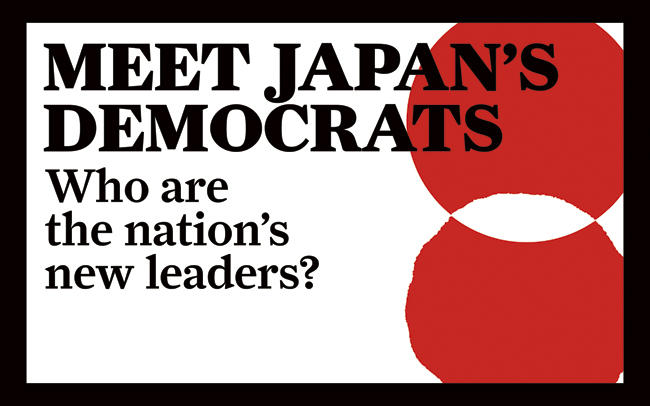The votes have been counted, and unsurprisingly the Democratic Party of Japan (DPJ) has emerged victorious, becoming the first party other than the LDP to wield a majority in Japan's House of Representatives since the LDP was created in 1955.
But despite its victory, the DPJ is poorly understood even by Japanese. So it is worth asking, who are Japan's Democrats?
In this post, I will try to address some common misunderstandings about the DPJ, many of which will undoubtedly be repeated as Japan and the world consider the implications of Japan's historic change of government.
Origins: The DPJ is the successor to a party now known as the former DPJ. The former DPJ was launched in 1996 by members of the former Japan Socialist Party (JSP; now the Social Democratic Party of Japan) and Sakigake, one of the microparties that participated in the non-LDP coalition that held power from 1993-1994. Both parties had joined in coalition with the LDP in 1994, and the founders of the DPJ feared the electoral consequences of that decision. Among those founders were Yukio Hatoyama, a member of Sakigake who had been deputy chief cabinet secretary in the Hosokawa government, Takahiro Yokomichi, a onetime JSP Diet member who had served three terms as Hokkaido's governor before returning to the Diet as a DPJ member in 1996, and Naoto Kan, who at the time became well known for his service as health minister dealing with the AIDS-tainted blood scandal, as well as Kunio Hatoyama, Yukio's brother.
One thing that becomes apparent from looking at the party's basic principles is the similarity to the platform upon which the new DPJ was elected in 2009. It is also worth noting the similarities between this document and Yukio Hatoyama's recent essay in VOICE, including the inclusion of certain phrases ("bottom-up democracy of co-existence and self-reliance," "fraternity," etc.). As I noted when Hatoyama was elected DPJ leader in May, the former DPJ was very much a Hatoyama family affair, to the point of its founding depending on the Hatoyama family fortune.
But the party was transformed from a Hatoyama New Party to the party now set to govern Japan through several waves of new arrivals to the party. In 1998, the dissolution of Ichiro Ozawa's New Frontier Party led to the creation first of a handful of tiny parties plus Ozawa's Liberal Party, and then to the union of the former DPJ and the NFP successor parties with the exception of the Liberal Party. The party's principles at its founding in 1998 can be clearly recognized in the party's 2009 election manifesto: decentralization, administrative reform, budgetary reform, political reform in the interest of a more transparent and bottom-up democracy, a certain skepticism with neo-liberalism, a stress on a social safety net suited for an age marked by an aging, shrinking population, a foreign policy that stressed the UN, cooperation with the US in other areas (i.e., non-security), and closer ties with Asian countries, and a security policy that largely retained cold war constraints and sought more regional security multilateralism.
The DPJ was further transformed when the party merged with Ichiro Ozawa's Liberal Party, a move opposed vociferously by some DPJ members, most notably Yukio Edano. The most notable consequence of the merger, of course, was that it brought Ozawa into the party, which was subsequently reshaped by Ozawa, although the party went through three leaders, faced a disastrous defeat in 2005, and went through an embarrassing scandal in 2006 that nearly broke the reeling party.
Ozawa almost single-handedly transformed the DPJ into the party capable of driving the LDP from power. He selected candidates, trained them, honed the party's message to reach voters in the provinces, and then tirelessly traveled the country to take the DPJ's message to the people and lend his support to his candidates. Hatoyama may be the face of the victory and the DPJ's first prime minister, but the DPJ's victory is Ozawa's victory.
A divided party?: Given the manner in which the DPJ developed, it is common to look at the DPJ and see a divided party. After all, it has former DPJ members and former JSP members in its ranks.
But to look at those two extremes and assume an irreconcilably divided party is mistaken, not least because it ignores the enormous mass between the two.
The DPJ that went into the 2009 campaign had, between the upper and lower houses, sixteen former JSP members (two who left the party after it had become the SDPJ) and twenty former LDP members. Of the latter, most of these members left the LDP in 1993. Most of the former Socialists have been in the DPJ since the creation of the former DPJ in 1996. Do the years spent away from their former parties count for nothing? This question applies doubly so to leaders like Ozawa and Hatoyama. Ozawa may have once been a rising star, but why do his years in the wilderness count for nothing?
Often ignored in accounts of the DPJ are the 134 members (before Sunday) who have spent their entire careers within the DPJ, a number that will of course swell thanks to the DPJ's overwhelming victory. The point is that these party members are dedicated to the party's ideas as outlined above and as translated into policy form in the party's 2009 manifesto.
There will inevitably be rifts as the party fills in the details surrounding its policies once in power, but differences in opinion along these lines are normal.
Another manner in which the DPJ is more united, at least compared to the LDP, is in its internal structure. The DPJ does not have the sprawling policy-making organization that is the LDP's policy research council. It has been a considerably more top-down organization than the LDP and customarily has had collective leadership, starting with Hatoyama and Kan at the party's birth and continuing onward through to the Ozawa-Hatoyama-Kan troika and the party's Next Cabinet, which early in the DPJ's existence replaced the general council (which in the LDP exerts a veto over the cabinet). Successful administrative reform will depend on the DPJ's bringing this tradition of top-down, collective leadership into government.
Identical to the LDP?: Another common argument about the DPJ is that it is nothing more than a pale imitation of the LDP. There are a couple ways to address this argument.
First, if this is in fact the case, so what? In most if not all developed democracies, intense ideological divides have narrowed so that center-left and center-right parties have moved ever closer and now compete more on the basis of administrative competence and corruption than on profound clashes based on policy or conforming to class cleavages. Why should Japan be any different?
But while the DPJ and the LDP differed largely on questions of how to pay for programs that neither side questioned in principle, there is one area in which the two parties differed radically: administrative reform. The LDP has long talked about administrative reform, but has only haltingly followed through on its rhetoric. The DPJ, however, has made clear that its first and most important order of business is shifting the balance of power between politicians and bureaucrats in favor of politicians in the cabinet, especially when it comes to budgeting. If the DPJ delivers on its proposals — and given its mandate, it is hard to see how it will fail to make at least some progress — it will be in a position to make more substantial policy changes.
Left wing?: Others argue that far from being identical to the LDP, the DPJ is actually a radical left wing party. There is little evidence to support this argument. Indeed, it is barely worth addressing. No party led by Ichiro Ozawa for three years, and before that Seiji Maehara, merits the label left wing.
Muddled policy: There is, of course, some truth to this argument, especially as far as the party's economic growth strategy is concerned. Others in Washington argue that the DPJ's position on foreign policy is muddled. I would be more concerned about the former than the latter. As I wrote last week, the DPJ is more united on foreign policy questions than often assumed, and on the realignment of US forces, the foreign policy issue most likely to be taken up by the Hatoyama government early on, the party is almost completely in agreement in opposition to the 2006 road map.
But while there are many remaining questions about how the DPJ will get Japan's economy growing again and fix the government's finances — new bond issues? dollar reserves? tax reform? — the DPJ will answer these questions soon.
What we can be sure about is that the biggest pieces of the DPJ's manifesto — child allowances, income support for farmers, free public high schools, toll free national expressways — will be assigned high priority by the new government. And on administrative reform, the party's position is clear: it will transform the balance of power within the government. The DPJ may make some tactical compromises as it pursues a new policy-making process, but it will make it a top priority.
There are unanswered questions about a DPJ government, one of the biggest being a triumphant Ichiro Ozawa's role in the new administration. But the party will enjoy a honeymoon and it has a huge majority with which to work. The Japanese public has certainly provided the DPJ with the perfect tool with which to implement its agenda.
Blog:
Other posts by Tobias Harris:







